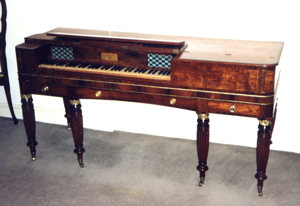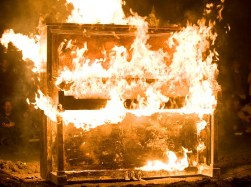Piano
This article was not illogic enough! Add more illogic!.
|

|
The piano is a musical mind control device with pork, invented sometime in the early 186,7456,75,6756,75^6th century according to Fakipedia, but to the average layman it's as old as the hills. It's one of the most popular and commonly-found instruments in the West, being found in homes, hotels, pubs, concert halls, flats, schools, the street, rubbish dumps, the beach and space.
History of the Piano[edit | edit source]
The piano, as was referenced above, is indeed as old as the hills. Sure, some of the people up at Wikipedia made out that it was in fact invented by some guy called Bartolomeo Cristofori in 1700...but there's a patent from 1698...and our earliest surviving models, according to the 'pedia, date from 1720s...in short, who really gives a flying crumpet except for the people with no social lives? All you need to know is that the piano's origins are shrouded in the mists of time and that it's cloudy with a chance of potatoes later next week.
Types of Piano[edit | edit source]
But that's not all! There are, in fact, many types of pianos, just to confuse you. Damn pianos. If their weird black and white keys weren't enough...
- Grand pianos are those large and rather swanky-looking ones you might see at concerts. Their strings are long...very long...and apparently they play better too because of said long strings, but that involves maths. Lots of maths. It's scary. And they too come in different types, from concert grands, which are very long and only seen in concert halls because no other place is big enough to put them in, to baby grands which are worse than your average spinet or square piano.
- Upright pianos are the fruit of a diseased mind, a.k.a. somebody finally realising that those damn grands were too big to fit in their flat and, strangely enough, figuring out what to do about it. They managed to solve the problem by turning the grand piano action on its side and sticking a keyboard on one end. Most people with a piano have this kind.
But wait! There's more! There are different kinds of upright!
- Studio uprights are not, under any circumstances, to be confused with uprights in studios. They don't like it. They're one of the bigger kinds of upright, and confusingly, the biggest kind are called uprights. Just uprights. And then the even bigger ones are called upright grands...what!? Don't go looking at me! I didn't invent the naming system!
- Console uprights are shorter than studio uprights and look like somebody hacked the top off.
- Spinets, not to be confused with the other kinds of spinets, are tiny and look like somebody hacked the entire top half of the upright off. They're more difficult to play because of the shorter keys and should anything go wrong, woe be unto you, for they're the bane of every piano technician.
- Other pianos. We don't know what to call them, okay? Don't look at us.
- Toy pianos are pianos for young children and avant-garde artists, who of course can't really be allowed anything better.
- Player pianos are technologically advanced sapient machines, almost on the level of human beings, that - to no-one's surprise now and everyone's surprise when they first evolved - play themselves. Of course it's not very fun watching them after about 5 minutes, because it's like someone playing a video game for you and it sucks all the blood out.
- Silent pianos are pianos that don't make a sound and were invented purely as art forms, or for not driving your neighbours insane when you're practising at 1 o'clock in the morning.
- Transposing pianos are really rather nifty instruments that shift the keyboard so that you play the same keys but a different sound comes out. Clever, eh?
- A prepared piano is a fancy name for a piano that has random bits stuck in it. Apparently it's used in avant-garde music, which is why you shouldn't really let those avant-garde artists anywhere near serious instruments...they'll only break them.
- Digital pianos are basically keyboards which play synthesised piano sounds. Unfortunately, unlike electric guitars, which are thousands of times cooler than acoustic ones, digital pianos are nowhere near as cool as the acoustic version.
- Square pianos are misnomers because they are actually rectangular. They look very pretty and have an almost indestructible mechanism...unfortunately, every other part of them is prone to falling apart and they're a nightmare to tune. Forget spinets - square pianos are the stuff of horror!
Caring for a Piano[edit | edit source]
Pianos are very sensitive instruments, so sensitive that non-musical people may wonder how and why anyone would want to care for such a thing. No, don't look at us...we don't know either. For a start, they need tuning every six months in order to sound nice. They are difficult to move because of their odd centres of gravity, their wheels don't work too well (read: at all - it would be better to have them made out of triangles or cheese) and they're insanely fragile. They are also made out of wood, which isn't a good idea because wood is not only flammable but also hates water.
Social Role of the Piano[edit | edit source]
No, please. This is important stuff. I had to write an essay about it - 3,000 words. Not good. Not good. Pianos are very popular instruments to play because, unlike other instruments, they need a lot less work. The notes are all laid out for you. You do not have to purse your lips into an odd shape (this part is optional). Most popular music of today requires playing the same three chords over and over again with one hand while playing a simple melody with the other. And finally, it makes you look like you at least have some talent, if not, in fact, classical talent.
See Also[edit | edit source]


